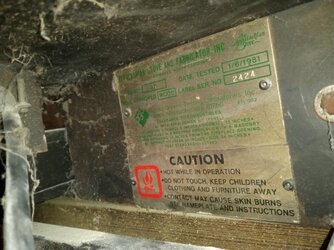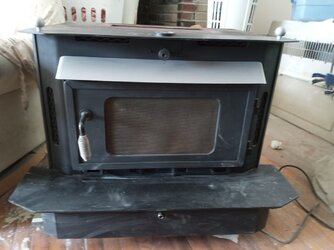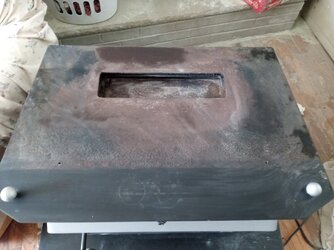Not sure if old stove uses a 6" or 8" liner...
- Thread starter woodisher
- Start date
-
Active since 1995, Hearth.com is THE place on the internet for free information and advice about wood stoves, pellet stoves and other energy saving equipment.
We strive to provide opinions, articles, discussions and history related to Hearth Products and in a more general sense, energy issues.
We promote the EFFICIENT, RESPONSIBLE, CLEAN and SAFE use of all fuels, whether renewable or fossil.
You are using an out of date browser. It may not display this or other websites correctly.
You should upgrade or use an alternative browser.
You should upgrade or use an alternative browser.
brenndatomu
Minister of Fire
What are the dimensions on that hole?
An 8" flue is 50 sq inches, and I'm guessing that is about what that hole measures too.
You have the chimney adapter to go on there?
An 8" flue is 50 sq inches, and I'm guessing that is about what that hole measures too.
You have the chimney adapter to go on there?
You're right. The opening is 50 sq inches. I'm thinking about getting this adapter I like how it comes off at a 45 degree angle, much easier to connect to the liner.What are the dimensions on that hole?
An 8" flue is 50 sq inches, and I'm guessing that is about what that hole measures too.
You have the chimney adapter to go on there?
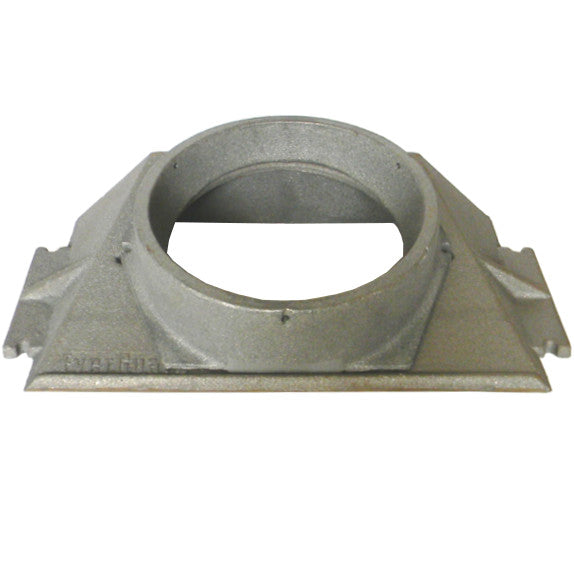
Adapter for Flex Liners to Inserts and Stoves - Chimney Adapter Boot
The fireplace adapter boots connect a fireplace insert with an oval or rectangle opening to a round flexible chimney liner. Free shipping. Install guide.
I'm also considering getting a 20 foot long liner instead of the 15 foot so that I can put it in front of the fireplace and get way more heat from it. This would especially be to my advantage if the blower goes out, considering this is a very old model and the company that made it went bye-bye.
The radiant heat from the stove will be strong. Is there a wood mantel on the fireplace or close side walls? Also, the hearth will need an extension that protects the floor out at least 16" in front of the stove door.I'm also considering getting a 20 foot long liner instead of the 15 foot so that I can put it in front of the fireplace and get way more heat from it. This would especially be to my advantage if the blower goes out, considering this is a very old model and the company that made it went bye-bye.
Brick stove and brick mantle. I was thinking about putting it in front of the mantle, on top of something (of course) so it's not directly up against the hard wood floor.The radiant heat from the stove will be strong. Is there a wood mantel on the fireplace or close side walls? Also, the hearth will need an extension that protects the floor out at least 16" in front of the stove door.
As far as the dusty floor goes, new roommates brought fleas so the powder on the ground is 3/4 diatomaceous earth and 1/4 neem, so the fleas are nearly extinct (haven't seen one in days). We have 4 cats and 2 dogs so the attention and time spent dusting them and the house has been extensive, but they are finally almost gone.
I've been wanting a wood stove for decades so I'm looking forward to using it!
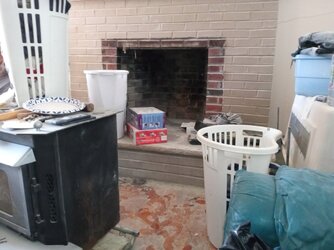
The all brick fireplace is good however, this is an insert, it's only meant to be installed in a masonry fireplace, not in front. It will be very hard if not impossible to connect to the liner if it's out too far from the fireplace. Don't worry too much about more heat. It will do ok. If the blower goes out, then the motor can be fixed or repaired.
Is this a catalytic model? If so, what condition is the cat in?
Is this a catalytic model? If so, what condition is the cat in?
Question. Why would it be hard or impossible to connect the liner if it's too far from the fireplace? The angle of the adapter and the connector that I'd get with it, coupled with the strength of the stainless steal and positioning, would make it a perfect easy fit.The all brick fireplace is good however, this is an insert, it's only meant to be installed in a masonry fireplace, not in front. It will be very hard if not impossible to connect to the liner if it's out too far from the fireplace. Don't worry too much about more heat. It will do ok. If the blower goes out, then the motor can be fixed or repaired.
Is this a catalytic model? If so, what condition is the cat in?
Unfortunately this is not a catalytic model, so I don't have that advantage which is why I'd especially like it to be more exposed.
And I don't mean to say that I want it to rest on the mantle outside the fireplace, because that WOULD be too hard to pull off with the liner. I want it to be in front of the mantle altogether, maybe a couple inches away from the front of the mantle. It would take up way more room and would look odd, but I don't care. I would think getting the liner to fit at that point would be a matter of just extending the piping out from the fireplace and slightly bending it. because the insert would be a foot below the fireplace altogether, close to the ground. The extra exposed pipe and fully exposed insert would make up for the loss of not having a catalytic combustor, and I could cook/boil off of it as well so I'd save on using the electric stove less.
Note that the mantel is the decorative framework surrounding the fireplace opening. It sounds like the hearth extension in front of the fireplace is what is being described.
This is overthinking it and potentially dangerous. The insert must sit on a 100% non-combustible hearth of at least 8" of masonry. It can not sit on the floor. Install it correctly. Burning dry wood it should perform well.
This is overthinking it and potentially dangerous. The insert must sit on a 100% non-combustible hearth of at least 8" of masonry. It can not sit on the floor. Install it correctly. Burning dry wood it should perform well.
Ok, I played around with ChatGPT and this is what it helped me come up with:Note that the mantel is the decorative framework surrounding the fireplace opening. It sounds like the hearth extension in front of the fireplace is what is being described.
This is overthinking it and potentially dangerous. The insert must sit on a 100% non-combustible hearth of at least 8" of masonry. It can not sit on the floor. Install it correctly. Burning dry wood it should perform well.
Basically,
0.75 inches worth of fireproof ceramic tiles on four corners on the floor (directly under where the stove will be) providing the first air buffer.
0.5 inch thick fireproof wood board will be placed on the tiles, and will extend about 8 inches outwards on 3 of the 4 sides (the back of the wood will be pushed up against the front of the fireplace mantle)
On top of that, 4 fireproof bricks (one on each corner where the stove will be) providing an additional 2.25 inch air gap between the fireproof wood and the stove.
ChatGPT:
The proposed method for safeguarding hardwood floors around a wood stove insert involves a careful arrangement that provides a 3.5-inch clearance, addressing a common concern when a wood insert is placed in an open area. This protective setup comprises three essential layers, starting with a layer of heat-resistant ceramic tiles directly placed on the floor. These tiles act as the first line of defense against the stove's heat, ensuring a secure buffer. Above the tiles, a fireproof board is positioned, designed to serve as an additional shield. The key innovation is the fireproof board's extension in all directions, creating a boundary that further distances the radiant heat from the stove and the floor.
The next critical element is the layer of fireproof bricks that tops the fireproof board. These bricks offer both insulation and elevation, with a 2.25-inch clearance between the stove insert and the fireproof board. This design balances the need for protection with practical functionality, allowing for adequate airflow within the liner. This multifaceted approach minimizes direct heat transfer to the hardwood floor while maintaining the wood stove insert's safe operation, even when it's exposed in an open space.
That will never meet code. Just put the insert in the fireplace as it's designed to be usedOk, I played around with ChatGPT and this is what it helped me come up with:
Basically,
0.75 inches worth of fireproof ceramic tiles on four corners on the floor (directly under where the stove will be) providing the first air buffer.
0.5 inch thick fireproof wood board will be placed on the tiles, and will extend about 8 inches outwards on 3 of the 4 sides (the back of the wood will be pushed up against the front of the fireplace mantle)
On top of that, 4 fireproof bricks (one on each corner where the stove will be) providing an additional 2.25 inch air gap between the fireproof wood and the stove.
ChatGPT:
The proposed method for safeguarding hardwood floors around a wood stove insert involves a careful arrangement that provides a 3.5-inch clearance, addressing a common concern when a wood insert is placed in an open area. This protective setup comprises three essential layers, starting with a layer of heat-resistant ceramic tiles directly placed on the floor. These tiles act as the first line of defense against the stove's heat, ensuring a secure buffer. Above the tiles, a fireproof board is positioned, designed to serve as an additional shield. The key innovation is the fireproof board's extension in all directions, creating a boundary that further distances the radiant heat from the stove and the floor.
The next critical element is the layer of fireproof bricks that tops the fireproof board. These bricks offer both insulation and elevation, with a 2.25-inch clearance between the stove insert and the fireproof board. This design balances the need for protection with practical functionality, allowing for adequate airflow within the liner. This multifaceted approach minimizes direct heat transfer to the hardwood floor while maintaining the wood stove insert's safe operation, even when it's exposed in an open space.
I like this idea. I'm thinking the fireproof wood that will go under the bricks (and above the ceramic tiles), should extend out by at least 12", making the distance in between the front of the stove door and the floor, at least 17-18".The radiant heat from the stove will be strong. Is there a wood mantel on the fireplace or close side walls? Also, the hearth will need an extension that protects the floor out at least 16" in front of the stove door.
I know that local codes are designed to keep everyone safe. Understood. And I get that they are meant to go into fireplaces. But I've always been the round peg in a square hole type of guy who goes against the grain. I am 100% about safety (of course), but I also know that bureaucrats aren't interested in basic science/physics and they love to throw the book at you every chance they get because they are a bunch of energy-vampire Karens. As we learned recently, gov has zero interest in science. As long as it's ACTUALLY safe, that's all I care about.
There is no fireproof wood that I know of. Masonry, cement, heavy-duty steel studs are non-combustible.I'm thinking the fireproof wood that will go under the bricks (and above the ceramic tiles), should extend out by at least 12", making the distance in between the front of the stove door and the floor, at least 17-18".
Agreed, the insert will heat well enough when properly installed.That will never meet code. Just put the insert in the fireplace as it's designed to be used
Alright, a cement board then.There is no fireproof wood that I know of. Masonry, cement, heavy-duty steel studs are non-combustible.
Agreed, the insert will heat well enough when properly installed.
As far as "well enough"... Isn't that relative? This is a 42 year old stove and it is not catalytic. The power goes out or there's an EMP then there's no fan as well. At that point what does well-enough mean? 50% efficiency? Out in the open means 100% efficiency, less wood used and it will heat up more of the house.
Just weighing the pros and cons. I am far from rich. If I were rich I would buy a new stove insert and throw it in there and it would be ridiculously efficient.
100% efficient outside the fireplace? No not even close.Alright, a cement board then.
As far as "well enough"... Isn't that relative? This is a 42 year old stove and it is not catalytic. The power goes out or there's an EMP then there's no fan as well. At that point what does well-enough mean? 50% efficiency? Out in the open means 100% efficiency, less wood used and it will heat up more of the house.
Just weighing the pros and cons. I am far from rich. If I were rich I would buy a new stove insert and throw it in there and it would be ridiculously efficient.
You may not care about the code but your insurance company certainly will. And the adjuster who comes out if there is ever a claim will have a field day with that.
Your plan for a hearth is nowhere near enough these are designed to go in a fireplace with a cement slab floor that has no combustibles contacting under it
If you want a freestanding stove sell this and buy a freestanding stove
john26
Minister of Fire
I own 2 inserts both sit in the one sticks out 9" the other the other around 7" including the door I have no problem keeping the house warm at all. Its a 3000 sq ft 2 story first floor first floor around 1700 sqft and usually warmer than needed. I only burn one insert at a time and I burn full time once lows are mid 30s or less. Personally I would be more worried about the efficiency of the stove than the efficiency of heat transfer. I would want a stove that would burn less wood. I really like 8 hour burn cycles work best for my personal schedule.
I bought off of Craig's List for 100 dollars and spent an additional 400 dollars on a UHaul to get it here. I didn't know anything about stoves else I wouldn't have bought it considering it's 42 years old and is not catalytic.
My house fortunately is only 1,100 square feet but it's also high up in the mountains and it can get cold up here in the winter.
New stove sounds great but I wouldn't have bought this one off of Craig's list if I could afford it. Someday I'll be able to get a new one and at that point I'll have to uninstall the 8" liner that I'm about to blow money on, and then install a 6" liner since all the new ones use those.
My house fortunately is only 1,100 square feet but it's also high up in the mountains and it can get cold up here in the winter.
New stove sounds great but I wouldn't have bought this one off of Craig's list if I could afford it. Someday I'll be able to get a new one and at that point I'll have to uninstall the 8" liner that I'm about to blow money on, and then install a 6" liner since all the new ones use those.
You can.buy a used freestanding stove as well. And do you even have room in your chimney for an insulated 8" liner?I bought off of Craig's List for 100 dollars and spent an additional 400 dollars on a UHaul to get it here. I didn't know anything about stoves else I wouldn't have bought it considering it's 42 years old and is not catalytic.
My house fortunately is only 1,100 square feet but it's also high up in the mountains and it can get cold up here in the winter.
New stove sounds great but I wouldn't have bought this one off of Craig's list if I could afford it. Someday I'll be able to get a new one and at that point I'll have to uninstall the 8" liner that I'm about to blow money on, and then install a 6" liner since all the new ones use those.
john26
Minister of Fire
You could clean it up make it look nice throw it back on craigslist or FB market place for $600 try to get your money back and put towards a modern stove with 6" flu.
Similar threads
- Replies
- 7
- Views
- 874
- Replies
- 11
- Views
- 699
- Replies
- 4
- Views
- 511
- Replies
- 1
- Views
- 550


